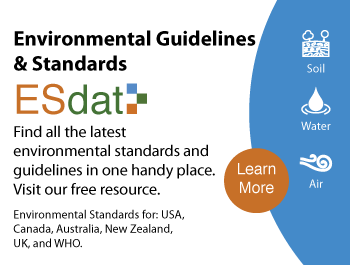Vapor intrusion (VI) occurs when volatile chemicals find their way from the subsurface to overlying buildings through preferential pathways or subsurface soils. Vapor intrusion affects the indoor air quality of the concerned buildings and leads to chronic or acute human health issues. Through the Technical Requirements for Site Remediation, the New Jersey Department of Environmental Protection (NJDEP) is responsible for providing requirements to be observed regarding vapor intrusion in buildings. NJDEP is also responsible for making and releasing updates spearheaded by advances in science and other technologies. The requirements apply to Licensed Site Remediation Professionals (LSRP), Non-LSRP environmental consultants, among other environmental professionals.
The development of VI screening levels and indoor remediation standards uses a risk-based approach to evaluate vapor intrusion linked to contaminated sites. It incorporates current scientific procedures and methodologies and collaboration with relevant bodies, including Interstate Technology and Regulatory Council (ITRC), ASTM, and the United States Environmental Protection Agency (USEPA).
The framework used for VI screening and indoor air quality remediation follows well-defined steps to accomplish its goals. The first step is VI receptor evaluation which involves conducting assessments to determine the potential for VI and the identification of receptors. The second step is petroleum VI screening, where PVI parameters and precluding factors are defined, whereas data evaluation is done using vertical screening distance. The third step is VI investigation, which involves developing and implementing the investigation and evaluation of data using the applicable screening levels. The fourth step consists in choosing the appropriate mitigation measure and its implementation. It is followed by monitoring and maintenance programs. The last step is the termination of the mitigation initiative.
All compiled environmental guidelines and standards are shown on the ESdat website. These are pre-loaded into ESdat Online. New Jersey (NJ) Vapour Intrusion Screening Levels and Indoor Remediation Standards are available.
ESdat is a single repository for storing, analysing and reporting your environmental investigation and monitoring data. ESdat validates and imports data from laboratories, data loggers, field apps and spreadsheets. Users can filter and view data using the built-in graphing, mapping, tabulation, statistical and report generation tools. Increasing efficiency and confidence in the data are often cited as key benefits by organisations using ESdat.
ESdat Online delivers a highly cost-effective and efficient approach to store your ongoing monitoring environmental data, optionally with a historical data upload provided as a getting started service. ESdat Online is perfect if you want a cloud-based system that collates and reports your ongoing laboratory and field results.
ESdat Server provides the advantages of ESdat Online with the option of adding ESdat Desktop for data experts to upload their historical data, effectively interrogate the raw data being used within the database, and automatically launch and send data to other Desktop Applications such as Surfer, ArcGIS and Excel.
A variety of complementary products are also available to help with related work, such as sample planning and electronic Chain of Custody (LSPECS), offline field data collection or bore logging (pLog), production of bore logs (ESlog), public portals and customized reporting.

Reference
NJDEP (2021). Vapor Intrusion Technical Guidance. Retrieved from https://www.nj.gov/dep/srp/guidance/vaporintrusion/vit_main.pdf






